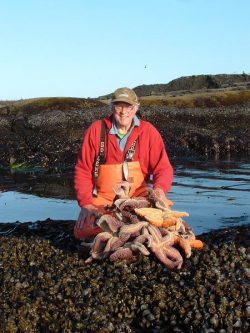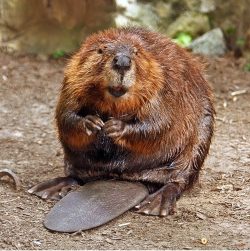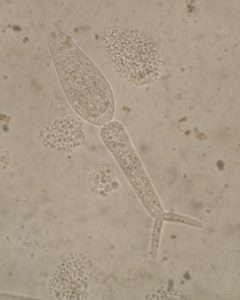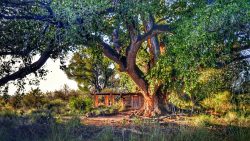To better understand big picture issues, it can sometimes be useful to bust out the magnifying glass and zoom in on the smaller details. Over the years, University of Washington College of the Environment researchers have discovered a multitude of ways in which seemingly small things can have giant impacts on much larger systems.
We’ve compiled a list of five of the best examples of things UW researchers discovered that are small, but mighty.

1. Certain animals are “keystone species” — species that entire ecosystems rely on
Pisaster ochraceus
In the 1960’s, UW Biology researcher Robert T. Paine first coined the term “keystone species”, which indicates an animal whose presence in certain habitats supports other animals and ecosystems at large. If a keystone species is removed from their habitats, entire ecosystems can collapse. The original animal that Robert T. Paine labelled as a keystone species, Pisaster ochraceus, has recently seen massive population declines in the Salish Sea as a result of sea star wasting disease. The population decline has resulted in booming sea urchin populations that are rapidly eating kelp forests relatively unchecked by their former predators.
Salmon
Salmon are another example of a keystone species in the Pacific Northwest. As they migrate inland to spawn, they carry with them essential nutrients gathered during their time spent in the open ocean. After they spawn and die, their decomposing bodies deliver nitrogen and other key nutrients to the landscapes around them, supporting riparian vegetation and more. Additionally, bears that eat the salmon later leave nutrient rich gifts near trees further from the streams. It’s also no secret to those in the PNW that salmon are essential for the health of the Southern Resident Killer Whales. Without salmon, animals and ecosystems both offshore and inland would face major challenges.

2. Leave it to beavers! These hard-working rodents play a huge role in river health
River systems can become degraded and unhealthy for many reasons. School of Aquatic and Fisheries Sciences (SAFS) researcher Gordon Holtgrieve was involved with a research team proposing that a certain semi-aquatic rodent might actually have a semi-solution to the process of river restoration. Beaver dams provide rivers with a plethora of restorative effects, including the generation of cooler pools of water for fish and the support of important riparian vegetation growth. Without hard-working beavers creating dams in river systems, restoration challenges would be much more difficult. While beavers provide some clues for more effective restoration processes, restoration ecology is is incredibly complex.
3. Tiny fish provide essential life support to large coral reef systems
Large, connected coral reefs can be some of the largest living organisms on the planet. SAFS researcher Luke Tornabene recently found that almost 60% of the fish food that organisms living in coral reefs eat comes from the tiny larvae of tiny fish like gobies and blennies. Some of these essential species have lifespans of only 65 days! Without this cycle of life and death, and the consistent flow of tasty larvae into the reef systems, the colorful, life abundant reefs (less so now due to climate change) could be far less spectacular.

4. Young prawns might be the answer to reducing one of the worst diseases on the planet
Blood flukes, small parasitic flatworms, are responsible for what the World Health Organization has designated as the second most devastating socioeconomic disease on the planet next to malaria: schistosomiasis. Before these flatworms reach adulthood and lay eggs inside humans, they first live inside intermediate freshwater snail hosts. At some point, the snail releases a free-swimming larval stage of the parasite that can directly penetrate the skin of unsuspecting humans on contact. Dams have been popping up in some regions where these freshwater snails live, with the unintended consequence of expanding the snails’ habitats. Even worse, the dams can sometimes separate the snails from one of their most common predators — prawns. Recently, SAFS’ Chelsea Woods found that reintroducing small prawns upstream from these dams can drastically reduce the prevalence of schistosomiasis in these regions. As an additional benefit, by the time the reintroduced prawns are big enough to eat, they no longer prey on the freshwater snails. So bringing back these tiny prawns will not only reduce the numbers of schistosomiasis infections, but can also contribute to the food supply!

5. Microscopic bacteria are big time neighbors for trees and plants
Trees and plants are capable of living in remarkably harsh environments. Some plants can survive in arid, scorched deserts, and others can survive at altitudes as high as 5,200 m – like the Poaceae high up on Nevado Sajama in Bolivia. While trees deserve a lot of credit for their resiliency, they wouldn’t get nearly as far without tiny little microbes. Sharon Doty from SEFS and the UW Microbiology department recently partnered to investigate how tiny microbes can actually keep trees alive in harsh conditions by delivering nitrogen or excess water when the trees communicate through chemical signaling that they need help!

